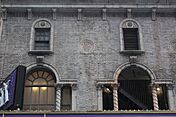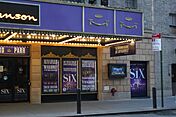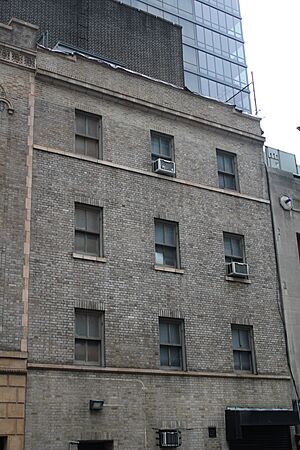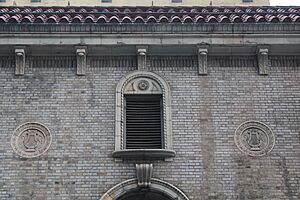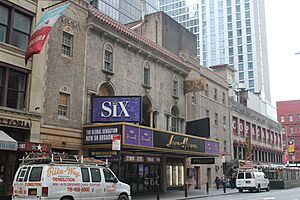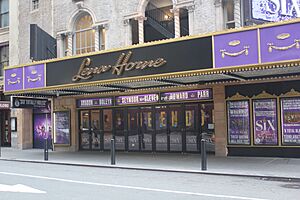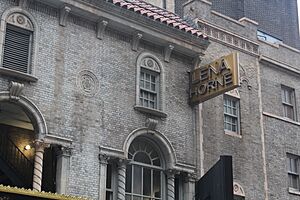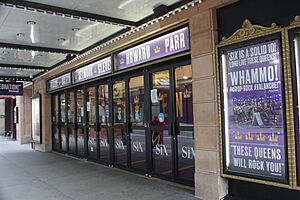Lena Horne Theatre facts for kids
|
|
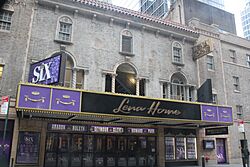
Showing Six, 2022
|
|
| Address | 256 West 47th Street Manhattan, New York United States |
|---|---|
| Coordinates | 40°45′36″N 73°59′13″W / 40.76000°N 73.98694°W |
| Owner | Nederlander Organization |
| Type | Broadway |
| Capacity | 1,069 |
| Production | Six |
| Construction | |
| Opened | February 15, 1926 |
| Years active | 1926–1950, 1960–present |
| Architect | Herbert J. Krapp |
| Designated | November 4, 1987 |
| Reference no. | 1311 |
| Designated entity | Facade |
| Designated | November 4, 1987 |
| Reference no. | 1312 |
| Designated entity | Auditorium interior |
The Lena Horne Theatre is a famous Broadway theater in New York City. It is located at 256 West 47th Street in the busy Theater District of Midtown Manhattan. The theater first opened its doors in 1926.
It was designed by Herbert J. Krapp in a beautiful Spanish Revival style. The theater has 1,069 seats for audience members. Today, the Nederlander Organization operates this historic venue. Both the outside (facade) and the inside (auditorium) of the theater are protected as New York City landmarks.
The theater's outside has two main parts. The stage area is four stories tall and made of light brown brick. The audience area is three stories tall and uses yellow-beige brick with fancy terracotta decorations. A large sign, called a marquee, covers the main entrance. Inside, the auditorium is decorated with detailed plasterwork. It has a sloped floor for the audience, a big balcony, and a curved ceiling. The balcony also has special box seats with murals painted above them.
The Lena Horne Theatre was originally called the Mansfield Theatre. It opened on February 15, 1926. For a while, it was even used by CBS for TV shows, known as Studio 59. In 1960, it became a theater again and was renamed the Brooks Atkinson Theatre. This name honored Brooks Atkinson, a well-known theater critic. The Nederlander Organization bought the theater in 1974. After a big update in 2000, it has hosted many popular shows, including the musical Waitress. On November 1, 2022, the theater was renamed the Lena Horne Theatre. This honored the famous singer, actress, and civil rights activist Lena Horne. The musical Six is currently playing there.
Contents
Where the Theater Is Located
The Lena Horne Theatre is at 258 West 47th Street. It is on the south side of the street, between Eighth Avenue and Broadway. This area is very close to Times Square in the Theater District of Midtown Manhattan, New York City.
The theater shares its block with the Paramount Hotel and the Hotel Edison. Other theaters nearby include the Samuel J. Friedman Theatre and the Lunt-Fontanne Theatre.
How the Theater Was Designed
The Lena Horne Theatre was designed by Herbert J. Krapp in 1926. It was built for the Chanin brothers. The theater was first named the Mansfield Theatre after British actor Richard Mansfield. From 1960 to 2022, it was called the Brooks Atkinson Theatre. This name honored Brooks Atkinson, a theater critic for The New York Times. Since 2022, the theater has been named for the amazing African-American actress and singer Lena Horne. The Nederlander Organization runs the theater today.
The Outside Look (Facade)
The theater's outside, or facade, has two main parts. The eastern part is three stories tall and wider. This is where the main entrance to the audience area is. It is made of yellow-beige brick with white terracotta decorations. The western part is four stories tall and holds the stage house. It is covered in brick.
Main Entrance Area
The first floor of the theater's front is very balanced. It has a marquee (a canopy) hanging over the main doors. These are five double metal doors that lead to the box office. There are also other doors and sign boards on this level.
On the upper floors, the front of the theater has three sections. The outer sections have single windows with round decorations above them. The middle section has three large Palladian window frames on the second floor. These windows are divided by twisting columns. The center opening is an open-air area with a fire escape. On the third floor, there are three more openings, some with windows and one with a vent. Medallions with lyres (a type of harp) are placed between these openings. A sign with the theater's name hangs from the third floor. The top of the facade has a decorative edge and a sloped tile roof.
Stage House Area
The stage house part of the Lena Horne Theatre is simpler. It is made of brick on all four stories. On the ground floor, there is a doorway and a garage opening. The upper floors have three windows each. The stage house also has a decorative top edge.
Inside the Theater (Auditorium)
The inside of the theater has a main floor for seating (the orchestra level), a balcony, and special box seats. The stage is located behind a large archway called the proscenium arch. The entire auditorium is decorated with beautiful plaster designs. The Nederlander Organization says the theater has 1,069 seats.
Seating Areas
The orchestra level, where the main seating is, slopes down towards the stage. At the back, there is a walkway with decorated walls. Two staircases lead from this walkway up to the balcony. The walls of the orchestra area have decorative panels and bronze lights.
The balcony is split into front and back sections by an aisle. Exit doors are located along this aisle. The side walls of the balcony have decorative panels with leaf designs. The front edge of the balcony is also decorated with shields and leaf patterns. Lights are built into this front edge. The underside of the balcony has plaster panels with crystal light fixtures.
On each side of the stage's archway, there are curved wall sections. Each section has three arches, and each arch holds a box seat at the balcony level. These box seats have crystal lights underneath them. The front of the boxes are curved and decorated with shields and leaf designs. Above the boxes are murals painted by A. Battisti and G. Troombul. These murals show characters from old Italian comedy and muses (goddesses of art).
Other Design Features
The proscenium arch, which frames the stage, is decorated with different patterns like leaves and ropes. Above the corners of the arch, there are sphinx designs. The arch is also flanked by decorated columns.
The ceiling is divided into two parts by a beam. The front part of the ceiling is curved and decorated with urns and leaf designs. A large crystal chandelier hangs from the center of this curved ceiling. The back part of the ceiling has panels with different shapes, like arches and diamonds. Four more chandeliers hang from this section.
History of the Theater
In the early 1900s, Times Square became the main place for big theater shows. Many theaters were built in Midtown Manhattan during this time. The Chanin brothers, who usually built real estate, also decided to build theaters in the mid-1920s. Irwin Chanin, one of the brothers, was inspired to build theaters because he remembered feeling embarrassed when he had to use a separate entrance for cheap seats as a student.
Early Broadway Shows
1920s
Irwin Chanin was new to Broadway when he built his first theater, the 46th Street Theatre. He hired Herbert Krapp, an experienced architect. After the 46th Street Theatre opened in 1925, Chanin had Krapp design the Biltmore and Mansfield theaters on 47th Street. The Mansfield Theatre opened on February 15, 1926, with a play called The Night Duel.
Many of the Mansfield's early shows were not very successful. The Night Duel only ran for 17 performances. However, If I Was Rich in September 1926 ran for 92 performances, which was a moderate success. Later, a play called The Ladder ran for hundreds of performances. The theater also hosted a revival of Eugene O'Neill's Beyond the Horizon. At the end of 1926, three Hebrew-language plays were performed by the Habima Players from Moscow, including The Dybbuk. In 1927, a revival of Ghosts with Minnie Maddern Fiske had 24 performances.
In 1928, the musical Present Arms by Rodgers and Hart ran for 147 performances. For a short time, the theater's sign even changed to "Lew Fields Theatre" after Lew Fields took over the lease. Another musical by Rodgers and Hart, Chee-Chee, was less popular. At the end of 1928, Lew Fields starred in Hello, Daddy, which ran for 198 performances. The theater went back to its original name, Mansfield Theatre, in March 1929.
1930s and 1940s
A big success at the Mansfield was Marc Connelly's The Green Pastures, which opened in February 1930. This play had an all-Black cast and ran for 640 performances. After this, many shows at the Mansfield were not successful, giving it a reputation as a "jinx house." The Chanin brothers lost control of the theater during the Great Depression. In 1932, the theater was bought by Nyamco Associates Inc.
The Mansfield reopened in December 1932 with Shuffle Along of 1933, but it closed quickly. In 1934, the comedy Page Miss Glory was moderately successful. In 1937, Antony and Cleopatra starring Tallulah Bankhead was staged. The Shuberts, another major theater group, leased the Mansfield in 1938 and updated it. In 1939, the long-running play What a Life moved to the theater.
In 1940, the Mansfield hosted a revival of Juno and the Paycock and the popular show Meet the People. Producer Michael Myerberg leased the theater in 1943 and then bought it in March 1944. In August 1944, Anna Lucasta opened, starring Hilda Simms. This play ran for 957 performances and was a huge hit. It was noted that Anna Lucasta and The Green Pastures, both with all-Black casts, were the theater's biggest successes.
In 1946, Ruth Gordon's Years Ago ran for 206 performances. The theater mostly had short runs in 1947. In 1948, the Dublin Gate Theatre performed three shows. The Mansfield's last shows of the 1940s included Red Gloves in 1948 and Lend an Ear in 1949.
Becoming a CBS Studio and Renaming
In August 1950, the Columbia Broadcasting System (CBS) leased the Mansfield Theatre for ten years. It became known as CBS Studio 59. Here, CBS broadcast popular TV shows like What's My Line? and I've Got a Secret.
In mid-1960, Michael Myerberg announced that the theater would be renovated and reopened for live shows. The Mansfield was renamed the Brooks Atkinson Theatre on September 7, 1960. This honored Brooks Atkinson, who had just retired as a theater critic. It was the first Broadway theater named after a theater critic.
Broadway Revival
1960s and 1970s
The first show at the Brooks Atkinson was Vintage '60 in September 1960, but it closed quickly. In 1961, Neil Simon's first play, Come Blow Your Horn, was a big success, running for 677 performances. In 1964, the theater hosted Tennessee Williams's The Milk Train Doesn't Stop Here Anymore and performances by Josephine Baker. The controversial play The Deputy ran for 318 performances that same year. In 1965, a revival of The Glass Menagerie ran for 176 performances.
From 1965 to 1967, the theater mostly had unsuccessful shows. To help, the Nederlander Organization bought half ownership of the Brooks Atkinson in May 1967. In 1968, A Day in the Death of Joe Egg and Lovers and Other Strangers were staged. Dustin Hoffman appeared in Jimmy Shine in late 1968 and early 1969. The theater had another hit in 1971 with Lenny, a play about Lenny Bruce, which ran for 453 performances. In 1973, The River Niger moved to the Brooks Atkinson and ran for 280 performances.
Michael Myerberg passed away in 1974, and the Nederlanders bought the rest of the theater. Three successful shows were staged that year: Find Your Way Home, My Fat Friend, and Of Mice and Men starring James Earl Jones. The comedy Same Time, Next Year opened in 1975 and ran for over 1,400 performances in total, moving to another theater in 1978. In 1978, Tribute with Jack Lemmon was staged. This was followed by the comedy Bedroom Farce in 1979.
1980s and 1990s
The play Talley's Folly moved to the Brooks Atkinson in 1980. After some short runs, The Dresser opened in 1981 and ran for 200 performances. In 1982, a revival of Ghosts with Liv Ullmann was staged. In 1983, the theater hosted the mountain-climbing play K2 and a solo show by Ben Kingsley. At the end of 1983, the popular comedy Noises Off opened and ran for one and a half years. In 1986, comedian Jackie Mason's solo show The World According to Me! ran for two years.
In 1987, the New York City Landmarks Preservation Commission decided to protect the Brooks Atkinson's outside and inside as landmarks. This meant the theater's historic features had to be preserved. The theater owners, including the Nederlanders, tried to challenge this decision in court, but the landmark status was upheld in 1992.
In 1989, Cafe Crown with Anne Jackson and Eli Wallach was staged. Musicians like Victor Borge and Peter, Paul and Mary also performed limited shows. In 1990, The Cemetery Club and Shadowlands were hosted. In 1992, Death and the Maiden with Glenn Close and Richard Dreyfuss was staged. The Roundabout Theatre Company's She Loves Me was shown in 1993. The theater had two unsuccessful plays in the mid-1990s.
In 1996, the Steppenwolf Theatre Company's Buried Child was produced. The musical Play On! was hosted in 1997. In 1998, the play Wait Until Dark starring film actress Marisa Tomei ran for 97 performances. In 1999, a revival of The Iceman Cometh from London, starring Kevin Spacey, was staged.
2000s to Present
In early 2000, the theater hosted Uncle Vanya. From July to September 2000, the theater underwent a $2.2 million renovation. The original chandelier was put back, and the lobbies, restrooms, seats, and carpets were updated. The Brooks Atkinson reopened in December 2000 with the musical Jane Eyre. A revival of Noises Off in 2001 ran for 348 performances. Other shows in the early 2000s included Medea in 2002 and The Look of Love in 2003. In 2004, the dramas Jumpers and Democracy were staged.
A revival of The Odd Couple opened in late 2005. This was followed by the musical The Times They Are a-Changin' in 2006 and A Moon for the Misbegotten in 2007. The rock-and-roll musical Grease was revived in August 2007 and ran for over a year. It was followed by the rock musical Rock of Ages, which opened in April 2009 and ran for almost two years.
In the early 2010s, the Brooks Atkinson hosted both plays and musicals. These included Rain: A Tribute to the Beatles in 2011, Peter and the Starcatcher in 2012, and After Midnight in 2013. In 2014, the Nederlanders agreed to make their theaters, including the Brooks Atkinson, more accessible for people with disabilities.
The Brooks Atkinson hosted the comedy It Shoulda Been You in 2015. The musical Spring Awakening was also staged that year. In 2016, the musical Waitress opened. It became the Brooks Atkinson's longest-running production in 2019 and closed on January 5, 2020. The musical Six was preparing to open on March 12, 2020, but all Broadway theaters had to close due to the COVID-19 pandemic. Six finally premiered when the Brooks Atkinson reopened on September 17, 2021.
During the pandemic shutdown, theater owners promised to increase diversity. In June 2022, the Nederlanders announced that the Brooks Atkinson would be renamed for singer and actress Lena Horne. Lena Horne had a strong connection with the Nederlanders, including her Broadway show Lena Horne: The Lady and Her Music in 1981. The Lena Horne Theatre became the first Broadway theater named after a Black woman. The new sign for the Lena Horne Theatre was revealed on November 1, 2022.
Famous Shows at the Theater
Here are some of the notable Broadway shows that have played at this theater, listed by when they first opened.
| Opening year | Name | Refs. |
|---|---|---|
| 1926 | Beyond the Horizon | |
| 1926 | The Dybbuk | |
| 1927 | Ghosts | |
| 1928 | Present Arms | |
| 1928 | Chee-Chee | |
| 1930 | The Green Pastures | |
| 1931 | The House of Connelly | |
| 1932 | Shuffle Along (1933) | |
| 1934 | Page Miss Glory | |
| 1936 | Black Limelight | |
| 1937 | Sea Legs | |
| 1937 | Antony and Cleopatra | |
| 1939 | What a Life | |
| 1939 | Thunder Rock | |
| 1940 | Juno and the Paycock | |
| 1940 | Meet the People | |
| 1941 | As You Like It | |
| 1944 | Anna Lucasta | |
| 1947 | The Cradle Will Rock | |
| 1948 | John Bull's Other Island | |
| 1948 | Red Gloves | |
| 1949 | Lend an Ear | |
| 1961 | Come Blow Your Horn | |
| 1963 | Phèdre | |
| 1963 | Bérénice | |
| 1963 | Man and Boy | |
| 1964 | The Milk Train Doesn't Stop Here Anymore | |
| 1964 | The Deputy | |
| 1965 | The Glass Menagerie | |
| 1967 | Love in E-Flat | |
| 1967 | A Minor Adjustment | |
| 1967 | Halfway Up the Tree | |
| 1968 | A Day in the Death of Joe Egg | |
| 1968 | Lovers and Other Strangers | |
| 1969 | Indians | |
| 1970 | Paris Is Out! | |
| 1970 | Charley's Aunt | |
| 1970 | Not Now, Darling | |
| 1971 | Lenny | |
| 1972 | Lysistrata | |
| 1973 | The River Niger | |
| 1974 | My Fat Friend | |
| 1974 | Of Mice and Men | |
| 1975 | Same Time, Next Year | |
| 1978 | Tribute | |
| 1979 | Bedroom Farce | |
| 1980 | Talley's Folly | |
| 1981 | Lolita | |
| 1981 | The Dresser | |
| 1982 | Beyond Therapy | |
| 1982 | Ghosts | |
| 1982 | Steaming | |
| 1983 | K2 | |
| 1983 | Edmund Kean | |
| 1983 | Noises Off | |
| 1985 | Aren't We All? | |
| 1985 | Benefactors | |
| 1986 | Rowan Atkinson at the Atkinson | |
| 1986 | Jackie Mason's The World According to Me! | |
| 1989 | Cafe Crown | |
| 1989 | The Victor Borge Holiday Show on Broadway | |
| 1989 | Peter, Paul & Mary "A Holiday Celebration" | |
| 1989 | Stephanie Mills Comes "Home" to Broadway | |
| 1990 | The Cemetery Club | |
| 1990 | Shadowlands | |
| 1992 | Death and the Maiden | |
| 1993 | Redwood Curtain | |
| 1993 | She Loves Me | |
| 1996 | Buried Child | |
| 1996 | Taking Sides | |
| 1997 | Play On! | |
| 1998 | Wait Until Dark | |
| 1998 | Fool Moon | |
| 1999 | The Iceman Cometh | |
| 1999 | The Rainmaker | |
| 2000 | Uncle Vanya | |
| 2000 | Jane Eyre | |
| 2001 | Noises Off | |
| 2002 | Medea | |
| 2003 | The Look of Love | |
| 2004 | Jumpers | |
| 2004 | Democracy | |
| 2005 | Mark Twain Tonight! | |
| 2005 | The Odd Couple | |
| 2006 | The Times They Are a-Changin' | |
| 2007 | A Moon for the Misbegotten | |
| 2007 | Grease | |
| 2009 | Rock of Ages | |
| 2011 | Rain: A Tribute to the Beatles | |
| 2011 | Relatively Speaking | |
| 2012 | Peter and the Starcatcher | |
| 2013 | Hands on a Hardbody | |
| 2013 | After Midnight | |
| 2014 | Love Letters | |
| 2015 | It Shoulda Been You | |
| 2015 | Spring Awakening | |
| 2016 | Waitress | |
| 2021 | Six |
Box Office Success
Waitress set a record for the theater in 2018. It earned $1,626,478 in one week. This record was later broken by Six. Six earned $1,649,206 in one week, ending January 1, 2023.
See also
- List of Broadway theaters
- List of New York City Designated Landmarks in Manhattan from 14th to 59th Streets



